电子科技大学:《语言学通论 General Linguistics》课程教学资源(课件讲稿)03 Formalist Approach
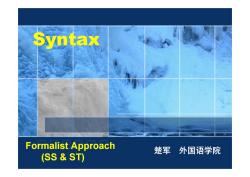
Syntax Formalist Approach 楚军外国语学院 (SS ST)
Formalist Approach (SS & ST) 楚军 外国语学院 Syntax
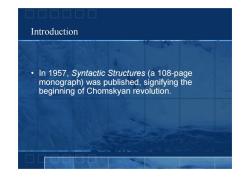
Introduction In 1957,Syntactic Structures (a 108-page monograph)was published,signifying the beginning of Chomskyan revolution
Introduction • In 1957, Syntactic Structures (a 108-page monograph) was published, signifying the beginning of Chomskyan revolution
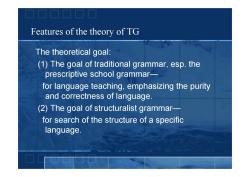
Features of the theory of TG The theoretical goal: (1)The goal of traditional grammar,esp.the prescriptive school grammar- for language teaching,emphasizing the purity and correctness of language. (2)The goal of structuralist grammar- for search of the structure of a specific language
Features of the theory of TG The theoretical goal: (1) The goal of traditional grammar, esp. the prescriptive school grammar— for language teaching, emphasizing the purity and correctness of language. (2) The goal of structuralist grammar— for search of the structure of a specific language
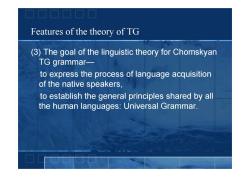
Features of the theory of TG (3)The goal of the linguistic theory for Chomskyan TG grammar- to express the process of language acquisition of the native speakers, to establish the general principles shared by all the human languages:Universal Grammar
Features of the theory of TG (3) The goal of the linguistic theory for Chomskyan TG grammar— to express the process of language acquisition of the native speakers, to establish the general principles shared by all the human languages: Universal Grammar
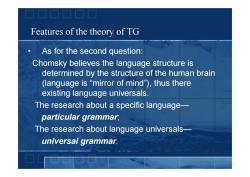
Features of the theory of TG As for the second question: Chomsky believes the language structure is determined by the structure of the human brain (language is "mirror of mind"),thus there existing language universals. The research about a specific language- particular grammar, The research about language universals- universal grammar
Features of the theory of TG • As for the second question: Chomsky believes the language structure is determined by the structure of the human brain (language is “mirror of mind”), thus there existing language universals. The research about a specific language— particular grammar; The research about language universals— universal grammar
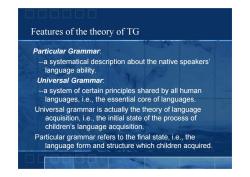
Features of the theory of TG Particular Grammar: --a systematical description about the native speakers' language ability. Universal Grammar: --a system of certain principles shared by all human languages,i.e.,the essential core of languages. Universal grammar is actually the theory of language acquisition,i.e.,the initial state of the process of children's language acquisition. Particular grammar refers to the final state,i.e.,the language form and structure which children acquired
Features of the theory of TG Particular Grammar: --a systematical description about the native speakers’ language ability. Universal Grammar: --a system of certain principles shared by all human languages, i.e., the essential core of languages. Universal grammar is actually the theory of language acquisition, i.e., the initial state of the process of children’s language acquisition. Particular grammar refers to the final state, i.e., the language form and structure which children acquired
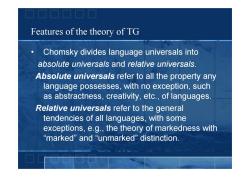
Features of the theory of TG Chomsky divides language universals into absolute universals and relative universals. Absolute universals refer to all the property any language possesses,with no exception,such as abstractness,creativity,etc.,of languages Relative universals refer to the general tendencies of all languages,with some exceptions,e.g.,the theory of markedness with “marked”and“unmarkedi”distinction
Features of the theory of TG • Chomsky divides language universals into absolute universals and relative universals. Absolute universals refer to all the property any language possesses, with no exception, such as abstractness, creativity, etc., of languages. Relative universals refer to the general tendencies of all languages, with some exceptions, e.g., the theory of markedness with “marked” and “unmarked” distinction
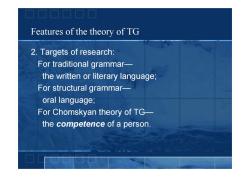
Features of the theory of TG 2.Targets of research: For traditional grammar- the written or literary language; For structural grammar- oral language; For Chomskyan theory of TG- the competence of a person
Features of the theory of TG 2. Targets of research: For traditional grammar— the written or literary language; For structural grammar— oral language; For Chomskyan theory of TG— the competence of a person
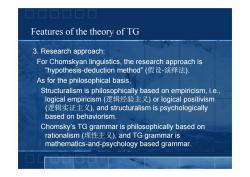
Features of the theory of TG 3.Research approach: For Chomskyan linguistics,the research approach is “hypothesis-.deduction method”(假设-演绎法) As for the philosophical basis, Structuralism is philosophically based on empiricism,i.e., logical empiricism(逻辑经验主义)or logical positivism (逻辑实证主义),and structuralism is psychologically based on behaviorism. Chomsky's TG grammar is philosophically based on rationalism(理性主义),and TG grammar is mathematics-and-psychology based grammar
Features of the theory of TG 3. Research approach: For Chomskyan linguistics, the research approach is “hypothesis-deduction method” (假设-演绎法). As for the philosophical basis, Structuralism is philosophically based on empiricism, i.e., logical empiricism (逻辑经验主义) or logical positivism (逻辑实证主义), and structuralism is psychologically based on behaviorism. Chomsky’s TG grammar is philosophically based on rationalism (理性主义), and TG grammar is mathematics-and-psychology based grammar
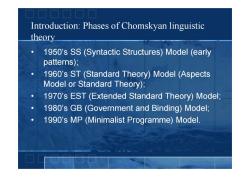
Introduction:Phases of Chomskyan linguistic theory 1950's SS(Syntactic Structures)Model (early patterns); 1960's ST(Standard Theory)Model (Aspects Model or Standard Theory); 1970's EST (Extended Standard Theory)Model; 1980's GB(Government and Binding)Model; 1990's MP(Minimalist Programme)Model
Introduction: Phases of Chomskyan linguistic theory • 1950’s SS (Syntactic Structures) Model (early patterns); • 1960’s ST (Standard Theory) Model (Aspects Model or Standard Theory); • 1970’s EST (Extended Standard Theory) Model; • 1980’s GB (Government and Binding) Model; • 1990’s MP (Minimalist Programme) Model
按次数下载不扣除下载券;
注册用户24小时内重复下载只扣除一次;
顺序:VIP每日次数-->可用次数-->下载券;
- 电子科技大学:《语言学通论 General Linguistics》课程教学资源(课件讲稿)02 句法 Syntax.pdf
- 电子科技大学:《语言学通论 General Linguistics》课程教学资源(课件讲稿)01 Introduction(主讲:楚军).pdf
- 山东省“成人教育特色课程”项目配套教材:《大学语文》课程教材电子版(主编:戴永新).pdf
- 聊城大学:《大学语文》课程教学资源(阅读文献)中国现当代文学经典作品选.pdf
- 聊城大学:《大学语文》课程教学资源(阅读文献)外国文学经典作品选.pdf
- 聊城大学:《大学语文》课程教学资源(阅读文献)中国古代文学经典作品选.pdf
- 聊城大学:《大学语文》课程教学资源(电子教案讲义,共十五讲).docx
- 运城学院:《文学概论 literature theory》课程教学资源(电子教案,打印版,2/2,共两编八章).pdf
- 运城学院:《文学概论 literature theory》课程教学资源(电子教案,打印版,1/2,共三篇八章).pdf
- 运城学院:《文学概论 literature theory》课程教学资源(教学大纲,打印版).pdf
- 运城学院:《秘书写作 Daily practical Writing》课程PPT教学课件(事务文书写作)15.总结述职报告.ppt
- 运城学院:《秘书写作 Daily practical Writing》课程PPT教学课件(事务文书写作)14.讣告悼词.ppt
- 运城学院:《秘书写作 Daily practical Writing》课程PPT教学课件(事务文书写作)13.欢迎欢送答谢表扬邀请信.ppt
- 运城学院:《秘书写作 Daily practical Writing》课程PPT教学课件(事务文书写作)12.聘书.ppt
- 运城学院:《秘书写作 Daily practical Writing》课程PPT教学课件(事务文书写作)11.请柬.ppt
- 运城学院:《秘书写作 Daily practical Writing》课程PPT教学课件(事务文书写作)10.求职信简历.ppt
- 运城学院:《秘书写作 Daily practical Writing》课程PPT教学课件(事务文书写作)09.倡议书建议书.ppt
- 运城学院:《秘书写作 Daily practical Writing》课程PPT教学课件(事务文书写作)08.启事.ppt
- 运城学院:《秘书写作 Daily practical Writing》课程PPT教学课件(事务文书写作)07.证明信.ppt
- 运城学院:《秘书写作 Daily practical Writing》课程PPT教学课件(事务文书写作)06.申请书.ppt
- 电子科技大学:《语言学通论 General Linguistics》课程教学资源(课件讲稿)04 Formalist Approach.pdf
- 电子科技大学:《语言学通论 General Linguistics》课程教学资源(课件讲稿)05 句法 Syntax.pdf
- 电子科技大学:《语言学通论 General Linguistics》课程教学资源(课件讲稿)06 Functional Grammar.pdf
- 电子科技大学:《语言学通论 General Linguistics》课程教学资源(课件讲稿)07 Semantics(Introduction).pdf
- 电子科技大学:《语言学通论 General Linguistics》课程教学资源(课件讲稿)语义学——Types of word-meaning.pdf
- 电子科技大学:《语言学通论 General Linguistics》课程教学资源(课件讲稿)语义学——Semantics(Sense Relations).pdf
- 电子科技大学:《语言学通论 General Linguistics》课程教学资源(课件讲稿)语义学——Context, changes in word meaning, figures of speech.pdf
- 电子科技大学:《语言学通论 General Linguistics》课程教学资源(课件讲稿)语义学——Componential Analysis.pdf
- 电子科技大学:《语言学通论 General Linguistics》课程教学资源(课件讲稿)语义学——Sentence meaning(Predication Analysis).pdf
- 电子科技大学:《语言学通论 General Linguistics》课程教学资源(课件讲稿)10 Langugae, culture & society.pdf
- 电子科技大学:《语言学通论 General Linguistics》课程教学资源(课件讲稿)09 Pragmatics(Utterance Meaning).pdf
- 电子科技大学:《语言学通论 General Linguistics》课程教学资源(课件讲稿)形态学 Morphology.pdf
- 电子科技大学:《语言学通论 General Linguistics》课程教学资源(课件讲稿)认知语言学中的相关话题 Cognitive Linguistics.pdf
- 弟子规(全文).pdf
- 《中国语言文化 Chinese Language and Culture》课程教学资源(书籍阅读材料)《中国古典哲学名著选读》郭齐勇.pdf
- 《中国语言文化 Chinese Language and Culture》课程教学资源(书籍阅读材料)《唐诗三百首》中英文对照(许渊冲)300 Tang Poems(Classified by Theme).pdf
- 《中国语言文化 Chinese Language and Culture》课程教学资源(书籍阅读材料)《二十四诗品校注译评》祖保泉.pdf
- 《中国语言文化 Chinese Language and Culture》课程教学资源(书籍阅读材料)《近代中国之种族观念》刘东.pdf
- 《中国语言文化 Chinese Language and Culture》课程教学资源(书籍阅读材料)《中国现代女作家与中国革命1905-1948》颜海平.pdf
- 《中国语言文化 Chinese Language and Culture》课程教学资源(书籍阅读材料)《世界秩序与文明等级》全球史研究的新路径(主编:刘禾).pdf
